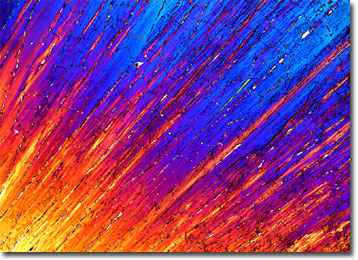Polarized Light Microscopy Digital Image Gallery
Aldicarb
Aldicarb is an extremely toxic insecticide that is often sold under the trade name Temik. Due to its classification as a restricted use pesticide in the United States, the chemical compound may only be legally purchased and utilized by certified applicators.

In order to reduce handling hazards, aldicarb is only available as a granular mix that is typically drilled into the soil during the planting of crops or at various stages of growth. Groundwater then solubilizes the insecticide so that it may be absorbed through the roots of plants and translocated throughout the organisms, effectively exterminating any insects that feed on their foliage as well as any nearby nematodes. Aldicarb is most commonly applied to peanut, cotton, and soybean crops, but it was also formerly popular as an insecticide for potatoes. However, in 1990, the manufacturer voluntarily put an end to its sale of the carbamate for this purpose due to concerns about groundwater contamination.
Unlike most carbamates, aldicarb is extremely noxious through both oral and dermal exposure routes. Dermal absorption of aldicarb, however, is only rapid if it is dispensed in an organic solvent such as oil. In such cases, the dermal toxicity of aldicarb is 1000 times as great as other carbamate insecticides. Also, the human body’s rapid absorption of the insecticide through the gut causes the onset of symptoms to occur very quickly in those that have accidentally ingested the substance. Symptoms of exposure to the cholinesterase inhibitor are predominantly neurological in nature and include such effects as sweating, weakness, nausea, blurred vision, tremors, and, in extreme cases, respiratory paralysis.
